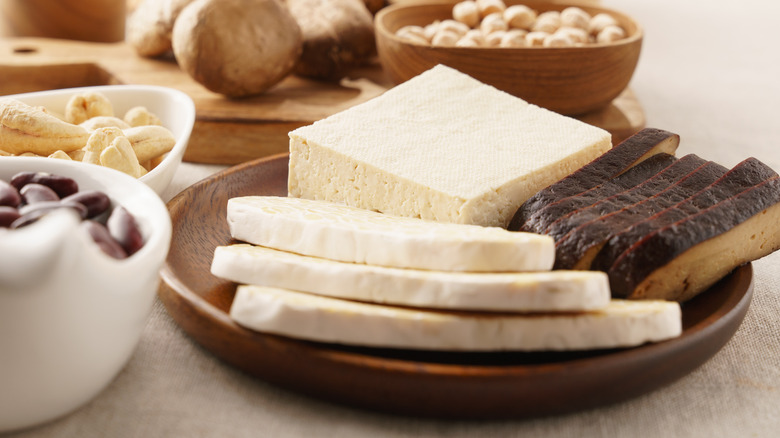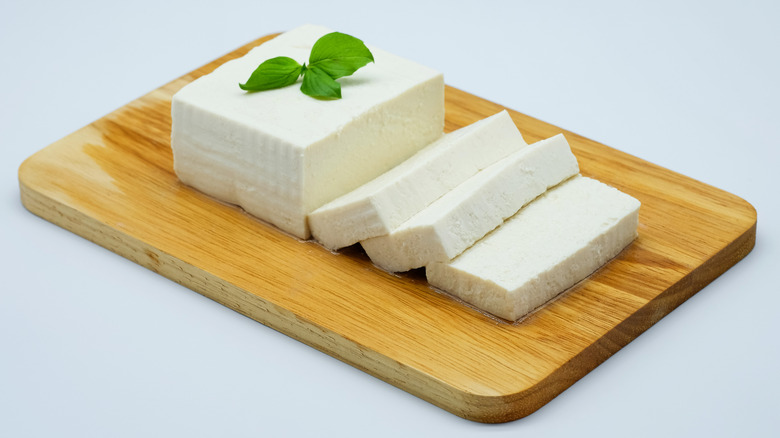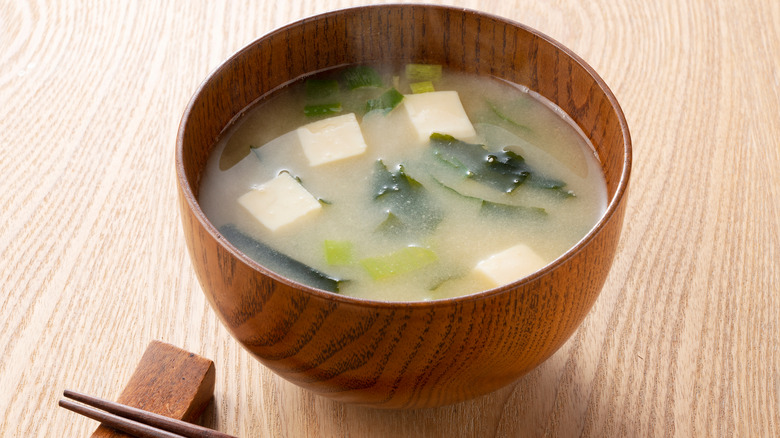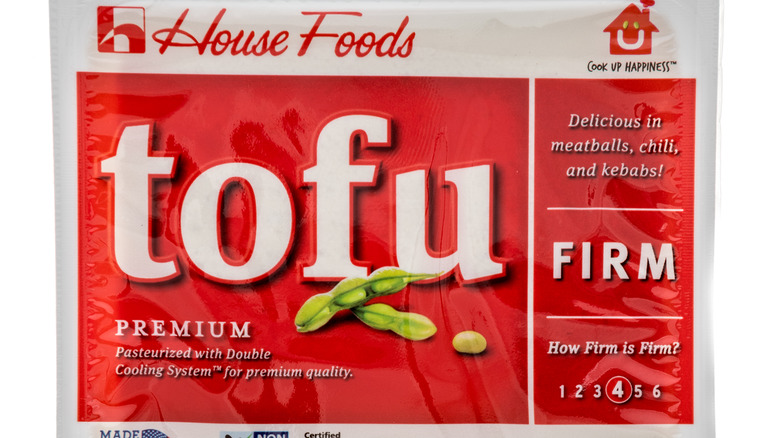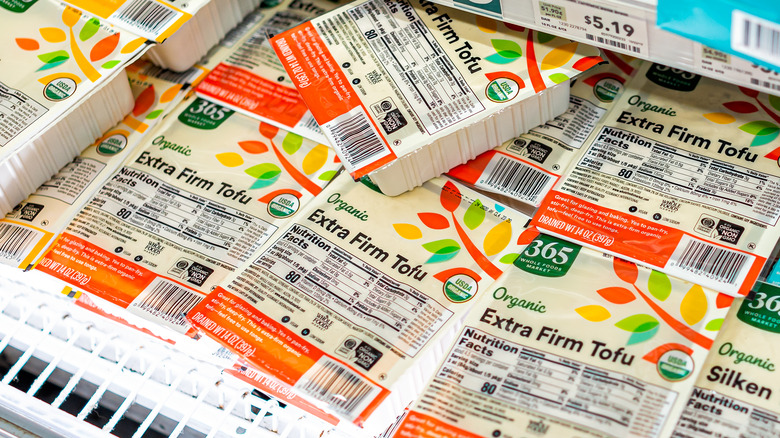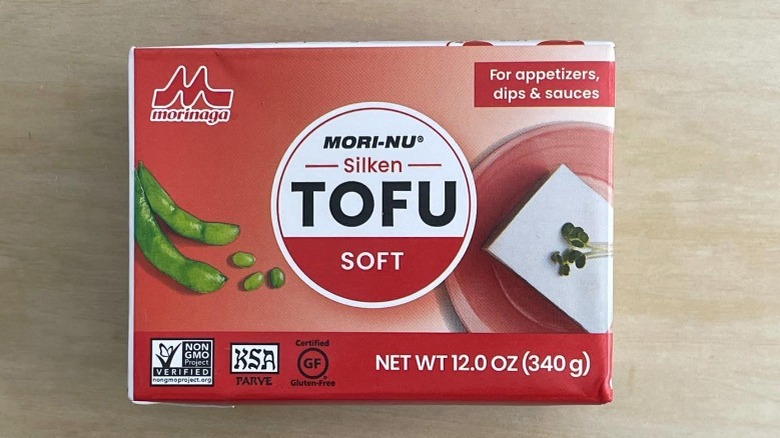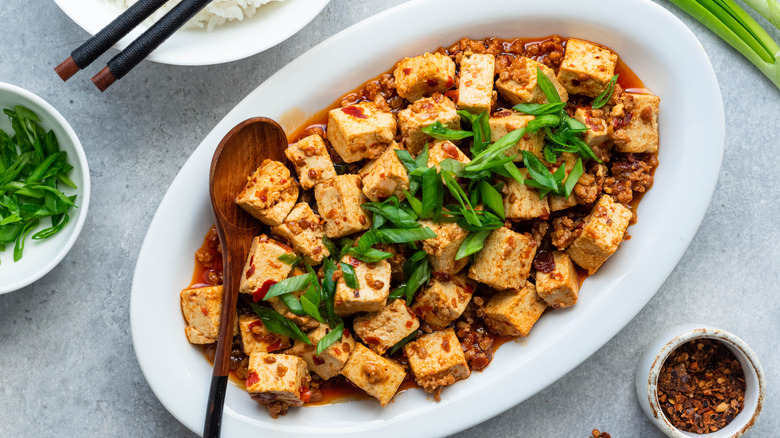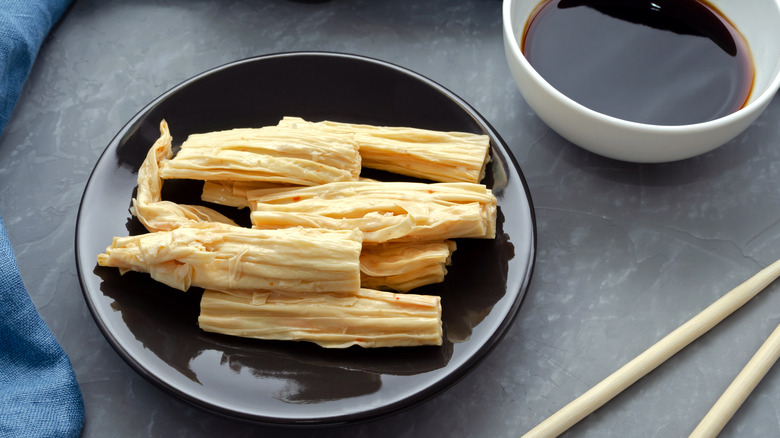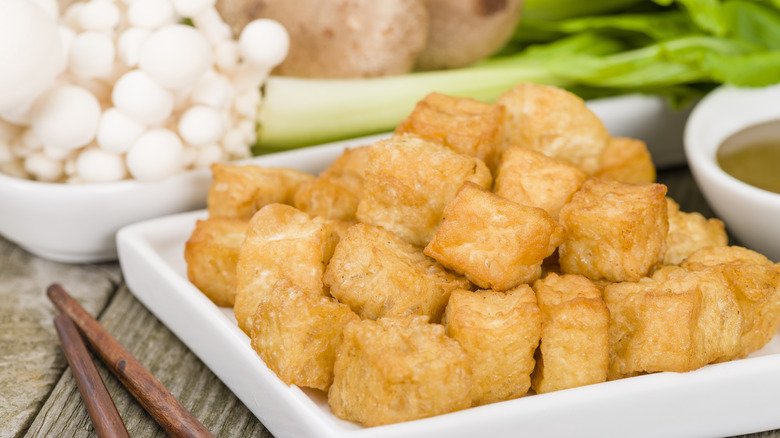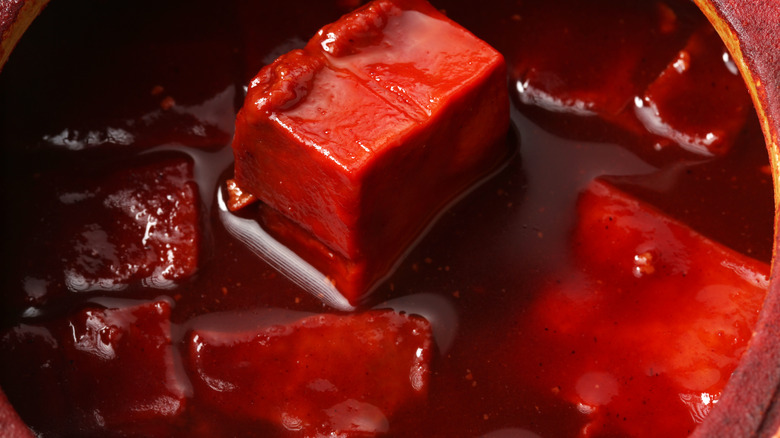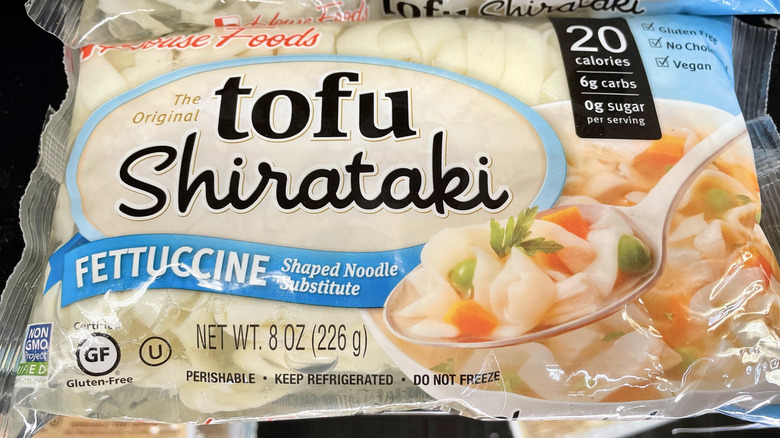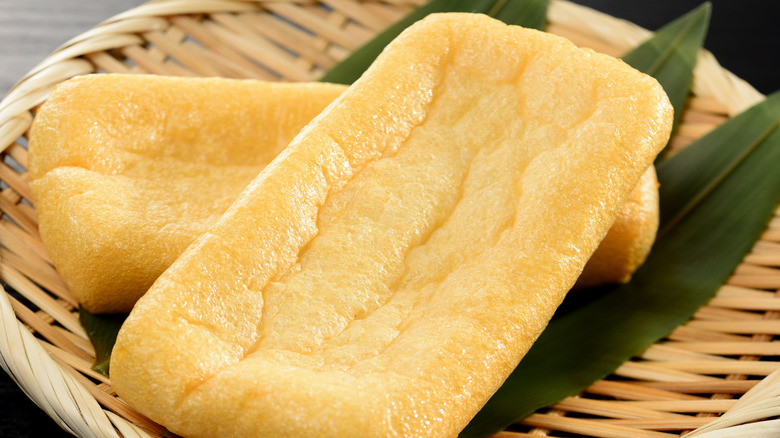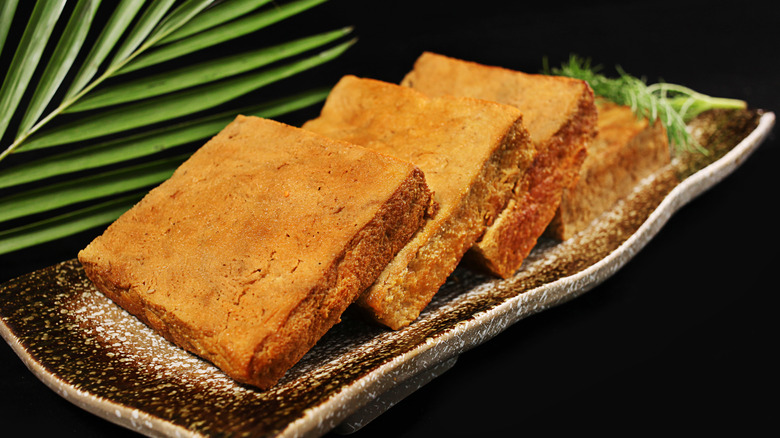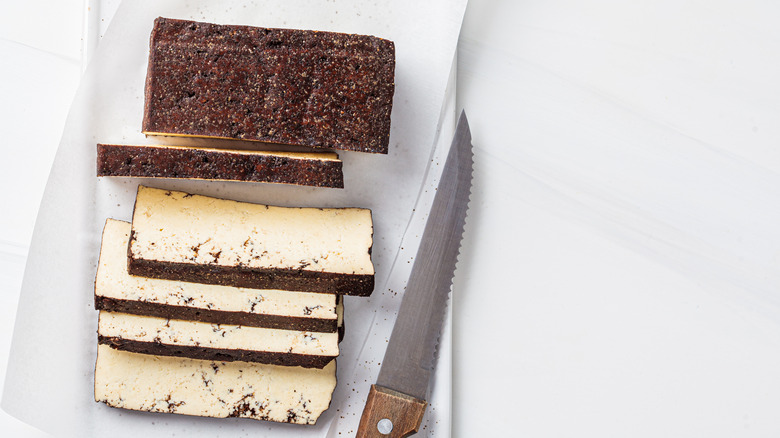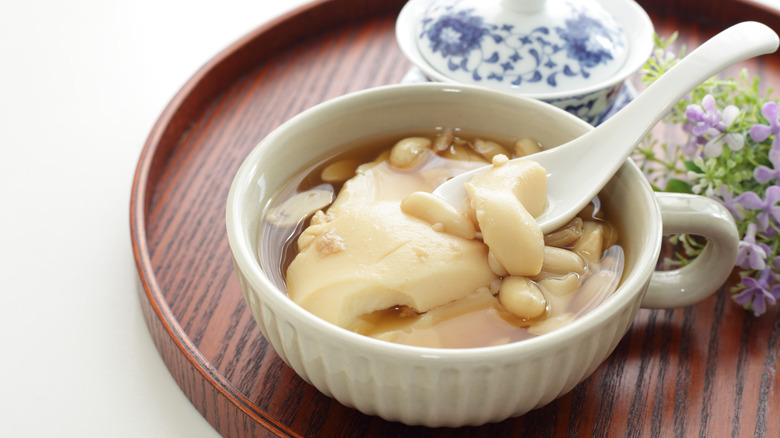14 Types Of Tofu And How To Cook Them
Tofu is a delicious and versatile type of food that has been around for millennia. In fact, according to Britannica, it originated in ancient China during the Han Dynasty a couple of thousand years ago. Tofu eventually made its way to Japan in the 8th century A.D. before spreading across to other parts of East Asia (via TofuBud). In the late 1900s, it became popular in the Western world as a way for vegans and vegetarians to eat more protein, and it remains a meatless staple for many people today.
Tofu is made from soybean curds that are pressed into blocks that vary in texture from soft to firm. The protein has a neutral flavor which makes it suitable for both sweet and savory dishes. Nutritionally, tofu is a good source of low-calorie protein, making it suitable for people who want to lose weight. It also contains several important vitamins and minerals including calcium, potassium, and iron.
Regardless of its star qualities, this soy-based protein can be divisive. If you have tried tofu before and didn't like it, don't give up on this nutritional powerhouse. Here are 14 different types of tofu and the tastiest ways to prepare them.
1. Soft block tofu
The most popular way to find tofu in the United States is in block form, which is made by curdling soy milk and pressing the curds. The tofu block can be soft, firm, or extra firm. As the Philadelphia Inquirer explains, softer tofu has a higher water content whereas the opposite is the case for firmer tofu. This distinction occurs in the processing stage; soft tofu is simply pressed for a short period of time which results in a watery, spongy texture. Don't confuse it with silken tofu (more on this type later), which is also quite soft but actually denser than block tofu varieties.
Because soft block tofu contains a lot of water, it will not hold up well to pan-frying or baking. Instead, use it in soups, stews, or dishes where it will be simmered in a sauce. Soft tofu can also be pureed and added to sauces or even desserts. Bob's Red Mill points out that its Jell-O texture makes it pleasant to enjoy raw.
2. Medium block tofu
Medium block tofu is very similar to soft block tofu but contains a little less water. This gives it a firmer texture, but it is still fairly soft and won't hold up well to frying or sautéing unless you don't mind it crumbling during the process (via House Foods). The taste is very mild and neutral, making it a great option for recipes that allow it to soak up a lot of flavor from seasonings and sauces.
According to House Foods, this type of tofu works particularly well in dressings and dips as a thickener. Medium-block tofu can also be crumbled and used as a vegan-friendly way to make scrambled eggs (via USDA). Many soups, including the popular miso one from Japan, opt for medium-firm tofu since it holds its shape during the cooking process. If you want firmer tofu but can't find firm or extra-firm varieties in your grocery store, you can press it to squeeze some of the water out. BBC Good Food suggests wrapping the entire block of tofu in a clean towel, placing a heavy frying pan on top, and letting it sit for several hours.
3. Firm block tofu
You probably guessed that firm block tofu is even firmer than soft or medium block tofu. This variety is easy to find in most grocery stores and can be used in plenty of recipes. According to Garlic Delight, firm tofu is tough enough to handle being stir-fried, although you're best off adding it once your vegetables are cooked to avoid a crumbly disaster.
You can also pan-fry or bake this type of tofu until the exterior is nice and crispy. If you're not planning on eating it right away, go ahead and freeze it. Thawing it will remove some of the water from inside, creating a spongy effect that allows the tofu to soak up tasty sauces and marinades more easily. Similar to medium block tofu, firm tofu can be crumbled and eaten with this unique texture. Verywell Fit suggests using it as a salad topper for a dose of protein with your veggies.
4. Extra-firm block tofu
Extra-firm block tofu has the firmest texture of all the varieties of block tofu. Consequently, the consistency is quite dense and it contains very little water. According to the tofu experts at Nasoya, extra-firm tofu can be used as a meat substitute in many different dishes, including kebabs, nuggets, and stir-fries. Although this type of tofu contains less water than others, Nasoya still recommends pressing and patting it dry to remove excess water before cooking. This will give it great texture once it's cooked, as well as allow the pieces to get nice and crispy if you're planning on frying or baking it.
Extra-firm tofu is undoubtedly extremely versatile. According to Well in Truth, it holds up well to grilling, deep-frying, and baking. Popular dishes that use it include pad thai, laksa (a spicy noodle soup from Southeast Asia), and curries. You can find extra-firm tofu at most Asian grocery stores and online, as well as in the Asian section of most supermarkets.
5. Soft silken tofu
Per the name, soft silken tofu has a very soft and smooth texture. As Garlic Delight explains, this tofu is made by mixing soy milk with a substance that helps the ingredients congeal. The mixture is then left to solidify in its packaging, which is usually a small cardboard container that does not need to be refrigerated. The silken stuff is not pressed before it is cooked or served, even though it contains more water than block tofu. Instead, it has a soft custard-like consistency straight out of the container, making it useful for a number of different preparations.
Soft silken tofu is so delicate that it will fall apart if you try to hold it or eat it with chopsticks. It can be eaten plain with a spoon but is more often blended into other dishes. Because of its mild flavor, you can add soft silken tofu to a smoothie for a protein boost without modifying the flavor. It can also be used as a thickener or egg substitute in many vegan dishes. Soft silken tofu can be found in most Asian grocery stores and some Western supermarkets too.
6. Firm silken tofu
Firm silken tofu may sound like an oxymoron, but hear us out. According to Livestrong, it is made just like soft silken tofu but uses a richer type of soy milk with a lower ratio of water. This results in the same creamy tofu that can be eaten with a spoon, but it also holds up to other cooking methods. Food writer and cook Andrea Nguyen recommends eating this type of tofu chilled and topped with soy sauce, ginger, and other herbs.
If you want to use it in vegan-friendly recipes, One Green Planet suggests blending it into dips and spreads, using it as an egg substitute, or even incorporating it into puddings and custards for extra creaminess. For many chefs, firm silken tofu is the ingredient of choice in mapo tofu, a specialty of the Szechuan Province in China (via The Guardian). It is also the main ingredient in sundubu-jjigae, a spicy and comforting Korean stew that can include assorted vegetables, meat, or seafood (via Taste Atlas).
7. Tofu skin
Tofu skin is an edible soy product that is also referred to as yuba. It is made by collecting the skin that forms on the top of soy milk when traditional tofu is being made (via Bon Appétit). The product is then dried and turned into various soy-based items. Tofu skin is thinner and less dense than tofu with a slightly chewy texture. The flavor is very mild, so it can be used in both sweet and savory dishes.
You can find tofu skin in most Asian grocery stores, sold as fresh sheets, fried rolls, and tofu sticks. Keep in mind that if you buy dried tofu skin, it will need to be soaked in water before you eat it, according to Taste Atlas. Yuba is sometimes used as a wrapper for other ingredients to make dishes like steamed buns, dumplings, and spring rolls. In its most basic form, a dish known as kumiage yuba consists of the soy milk film before it is processed or dried (via Hodo Foods).
8. Tofu puffs
Tofu puffs are deep-fried soy curds or tofu cubes with a chewy, spongy texture and a mild taste. You can purchase tofu puffs at many Asian grocery stores, although they will need to be reheated first for a more enjoyable experience (via Superior Natural). You can also make them at home if you're confident to deep-fry them yourself.
According to the blog A Veg Taste From A to Z, tofu puffs are essentially deep-fried cubes of tofu, but you shouldn't use just any kind of tofu. While extra-firm tofu works best for many fried recipes, you'll want the fresh medium-firm type to make this dish. Shelf-stable tofu varieties (like silken tofu) can work as emergency substitutions in some dishes, but tofu blocks packed in water in the refrigerated section of your grocery store will give you a much better end product. The result will be soft, pillowy cubes of tofu that have a hollow-like interior.
Tofu puffs can be eaten as-is or stuffed for an even more incredible treat. You may be able to find very fresh (as in made that morning) tofu at some Asian grocery stores, but the refrigerated packaged tofu you can find at most American supermarkets will work fine. Tofu puffs are frequently used as a vegan or meat-free substitute in a number of Asian dishes.
9. Fu ru
Fu ru is a type of fermented tofu from China that is meant to be used in small doses. According to Food & Wine, it is also called jiang dou fu and it is usually stored in the refrigerator in jars. You'll quickly be able to identify it thanks to its potent smell and strong flavor. There are several varieties of fu ru, but the two most common are white and fiery red (via Zolima City Mag). The white version is brined in seasoned sesame oil or rice wine and often contains chili flakes for added flavor. The red version sits in fermented red rice yeast for a period of time until it's packed with flavor.
The fermenting process makes both types creamy and spreadable, with a taste that can be likened to blue cheese or feta cheese with a hint of umami. Of course, the actual flavor will depend on how it's prepared and what other ingredients are used. Fu ru can be eaten plain or added to many Chinese dishes for a punch of deliciously funky flavor.
10. Tofu noodles
Often referred to as tofu shirataki noodles or konjac noodles, these are made from tofu and flour made from the konjac plant (via Healthline). Konjac is a type of root vegetable that grows in China, Japan, and parts of Southeast Asia. By mixing tofu, konjac flour, regular water, and limewater (a mixture of calcium hydroxide in water), you can create a lower-calorie healthier noodle. Konjac noodles can be used in any dish where you want a little more protein and fewer carbs. They're also vegan, gluten-free, and come in a variety of shapes and sizes.
The texture of tofu noodles is slightly chewy with a bit of a bite, similar to al dente pasta. The taste is fairly neutral, so they take on the flavors of whatever sauce or dish you're adding them into. You can find tofu shirataki noodles online or at most Asian markets. They usually come packed in water and need to be rinsed before cooking to eliminate any strange salty flavors from the packaging (via House Foods). You'll want to blanch the noodles if you are serving them cold, whereas if you are eating them warm simmer them in a broth or stir-fry them in a sauce. Either way, don't forget to rinse them and you'll have a delicious and healthy dish.
11. Aburaage tofu
Aburaage tofu is a type of Japanese tofu with a unique texture. As Taste Atlas explains, aburagge is made by double frying thin sheets of tofu. The result is a tofu pocket that is crispy on the outside and soft on the inside, with the ability to soak up other ingredients like sauces and soups. While the flavor is fairly neutral, the contrasting texture is what really sets aburaage tofu apart and makes for a unique and enjoyable experience.
According to the food blog Just One Cookbook, aburaage can be made at home by cutting firm tofu into thin slices and deep-frying them twice. This preparation has a mild taste and works well when incorporated into other dishes. Some popular Asian meals that use it include inari sushi, donburi, and oden (a one-pot dish with assorted ingredients). It is also a popular topping for soups like ramen and udon.
12. Doufu Gan
Doufu gan is a type of Chinese tofu that looks, feels, and tastes different than the standard blocks of tofu you'll find in a typical grocery store. According to Bon Appétit, this type of tofu is pressed longer than other block tofu varieties, creating a denser consistency. To add flavor, doufu gan is braised in soy sauce and seasonings until it has turned a rich brown color and the taste has seeped into every pocket and crevice.
Dofu gan is often enjoyed plain because it is already so full of flavor. However, its firm, dense texture lets it put up with a lot of handling so it also works well when stir-fried, baked, or deep-fried. Dofu gan isn't something you'll find in your average grocery store, but it's worth seeking out a well-stocked Asian market to find a package of this stuff. Whether you eat it plain or fry it to top off a bowl of rice, this is a type of tofu you'll definitely want to taste.
13. Smoked tofu
Smoked tofu is relatively straightforward to explain, in that it is basically a method to add flavor to traditional block tofu. The tofu brand SoyBoy sells prepackaged smoked tofu that is described as regular tofu that has been baked, seasoned, and smoked. The result is a chewy, flavorful product that works wonderfully as a protein substitute in many dishes.
Some people don't enjoy tofu because of its mild flavor, and smoking it is a great remedy to that complaint. As Brain Food Studio points out, tofu's spongy texture absorbs a lot while it's being prepared and cooked. Add a few spices and you've got yourself a piece of protein that tastes just as good as a slice of chicken or steak.
You can buy smoked tofu in many grocery stores or make it yourself if you have access to a smoker. Opt for extra-firm block tofu to make sure it doesn't fall apart during the process. Smoked tofu can be used in place of meat in many dishes or as a snack by itself.
14. Douhua
Although it is technically its own dish, douhua revolves around freshly-made tofu. The classic Chinese dessert is essentially a tofu pudding that only requires a few ingredients to make (via 196 Flavors). According to Omnivore's Cookbook, the result is even softer than silken tofu, with a creamy custard-like texture. The process itself is very similar to making silken tofu and involves cooking soy milk with a coagulant. It is then usually steamed to create a soft, jiggly final product.
You'll often find it as a sweet dish, but some people prefer to make it savory. When eaten as a dessert, douhua is often served with a ginger syrup made with brown sugar, water, and ginger. Meanwhile, when it is enjoyed as a savory dish in China, it is frequently topped with minced pork and gravy. Feel free to top douhua with whatever sounds good to you. The mild tofu flavor will go well with any add-ons that strike your fancy.
